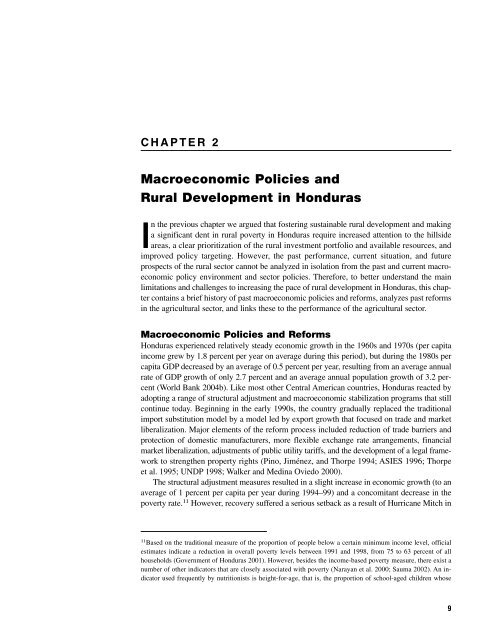Rural Development Policies and Sustainable Land Use in the ...
Rural Development Policies and Sustainable Land Use in the ...
Rural Development Policies and Sustainable Land Use in the ...
Create successful ePaper yourself
Turn your PDF publications into a flip-book with our unique Google optimized e-Paper software.
CHAPTER 2<br />
Macroeconomic <strong>Policies</strong> <strong>and</strong><br />
<strong>Rural</strong> <strong>Development</strong> <strong>in</strong> Honduras<br />
In <strong>the</strong> previous chapter we argued that foster<strong>in</strong>g susta<strong>in</strong>able rural development <strong>and</strong> mak<strong>in</strong>g<br />
a significant dent <strong>in</strong> rural poverty <strong>in</strong> Honduras require <strong>in</strong>creased attention to <strong>the</strong> hillside<br />
areas, a clear prioritization of <strong>the</strong> rural <strong>in</strong>vestment portfolio <strong>and</strong> available resources, <strong>and</strong><br />
improved policy target<strong>in</strong>g. However, <strong>the</strong> past performance, current situation, <strong>and</strong> future<br />
prospects of <strong>the</strong> rural sector cannot be analyzed <strong>in</strong> isolation from <strong>the</strong> past <strong>and</strong> current macroeconomic<br />
policy environment <strong>and</strong> sector policies. Therefore, to better underst<strong>and</strong> <strong>the</strong> ma<strong>in</strong><br />
limitations <strong>and</strong> challenges to <strong>in</strong>creas<strong>in</strong>g <strong>the</strong> pace of rural development <strong>in</strong> Honduras, this chapter<br />
conta<strong>in</strong>s a brief history of past macroeconomic policies <strong>and</strong> reforms, analyzes past reforms<br />
<strong>in</strong> <strong>the</strong> agricultural sector, <strong>and</strong> l<strong>in</strong>ks <strong>the</strong>se to <strong>the</strong> performance of <strong>the</strong> agricultural sector.<br />
Macroeconomic <strong>Policies</strong> <strong>and</strong> Reforms<br />
Honduras experienced relatively steady economic growth <strong>in</strong> <strong>the</strong> 1960s <strong>and</strong> 1970s (per capita<br />
<strong>in</strong>come grew by 1.8 percent per year on average dur<strong>in</strong>g this period), but dur<strong>in</strong>g <strong>the</strong> 1980s per<br />
capita GDP decreased by an average of 0.5 percent per year, result<strong>in</strong>g from an average annual<br />
rate of GDP growth of only 2.7 percent <strong>and</strong> an average annual population growth of 3.2 percent<br />
(World Bank 2004b). Like most o<strong>the</strong>r Central American countries, Honduras reacted by<br />
adopt<strong>in</strong>g a range of structural adjustment <strong>and</strong> macroeconomic stabilization programs that still<br />
cont<strong>in</strong>ue today. Beg<strong>in</strong>n<strong>in</strong>g <strong>in</strong> <strong>the</strong> early 1990s, <strong>the</strong> country gradually replaced <strong>the</strong> traditional<br />
import substitution model by a model led by export growth that focused on trade <strong>and</strong> market<br />
liberalization. Major elements of <strong>the</strong> reform process <strong>in</strong>cluded reduction of trade barriers <strong>and</strong><br />
protection of domestic manufacturers, more flexible exchange rate arrangements, f<strong>in</strong>ancial<br />
market liberalization, adjustments of public utility tariffs, <strong>and</strong> <strong>the</strong> development of a legal framework<br />
to streng<strong>the</strong>n property rights (P<strong>in</strong>o, Jiménez, <strong>and</strong> Thorpe 1994; ASIES 1996; Thorpe<br />
et al. 1995; UNDP 1998; Walker <strong>and</strong> Med<strong>in</strong>a Oviedo 2000).<br />
The structural adjustment measures resulted <strong>in</strong> a slight <strong>in</strong>crease <strong>in</strong> economic growth (to an<br />
average of 1 percent per capita per year dur<strong>in</strong>g 1994–99) <strong>and</strong> a concomitant decrease <strong>in</strong> <strong>the</strong><br />
poverty rate. 11 However, recovery suffered a serious setback as a result of Hurricane Mitch <strong>in</strong><br />
11<br />
Based on <strong>the</strong> traditional measure of <strong>the</strong> proportion of people below a certa<strong>in</strong> m<strong>in</strong>imum <strong>in</strong>come level, official<br />
estimates <strong>in</strong>dicate a reduction <strong>in</strong> overall poverty levels between 1991 <strong>and</strong> 1998, from 75 to 63 percent of all<br />
households (Government of Honduras 2001). However, besides <strong>the</strong> <strong>in</strong>come-based poverty measure, <strong>the</strong>re exist a<br />
number of o<strong>the</strong>r <strong>in</strong>dicators that are closely associated with poverty (Narayan et al. 2000; Sauma 2002). An <strong>in</strong>dicator<br />
used frequently by nutritionists is height-for-age, that is, <strong>the</strong> proportion of school-aged children whose<br />
9
















